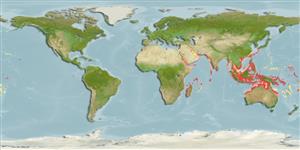>
Clupeiformes (Herrings) >
Dussumieriidae (Round herrings)
Etymology: Dussumieria: In honor of Dussumier, a collaborator of Cuvier, who sent him collections of fishes from the Indian Ocean (Ref. 45335).
Eponymy: Jean-Jacques Dussumier (1792–1883) was a French merchant, collector, traveller and ship owner. [...] (Ref. 128868), visit book page.
More on author: Bleeker.
Environment: milieu / climate zone / depth range / distribution range
Ecologia
marino; distribuzione batimetrica 0 - 50 m (Ref. 188). Subtropical; 31°N - 26°S, 32°E - 168°W (Ref. 188)
Indo-Pacific: Suez and western Indian Ocean (the Persian Gulf to Mombasa; possibly to Madagascar) to China, the Arafura Sea (Ref. 9819) and to about Tonga. Previous records of Dussumieria acuta from northeastern Indian Ocean would refer to this species (Ref. 5978).
Size / Peso / Age
Maturity: Lm ? range ? - ? cm
Max length : 20.0 cm SL maschio/sesso non determinato; (Ref. 188)
Spine dorsali (totale) : 0; Raggi dorsali molli (totale) : 16 - 18; Spine anali: 0; Raggi anali molli: 14 - 18. Branchiostegal rays more (13 to 17) and no striae on posterior part of scales; pelvic fins more advanced; W-shaped pelvic scute; isthmus with tapering evenly forward; more anal fin rays.
Pelagic inshore (Ref. 68964). The habitat and biology are presumably similar to those of D. acuta from which this species was not distinguished in earlier studies. Marketed fresh, may be dried or salted (Ref. 5284).
Life cycle and mating behavior
Maturità | Riproduzione | Deposizione | Uova | Fecundity | Larve
Whitehead, P.J.P., 1985. FAO Species Catalogue. Vol. 7. Clupeoid fishes of the world (suborder Clupeoidei). An annotated and illustrated catalogue of the herrings, sardines, pilchards, sprats, shads, anchovies and wolf-herrings. FAO Fish. Synop. 125(7/1):1-303. Rome: FAO. (Ref. 188)
IUCN Red List Status (Ref. 130435: Version 2024-1)
Threat to humans
Harmless
Human uses
Pesca: scarso interesse commerciale
Strumenti
Special reports
Download XML
Fonti Internet
Estimates based on models
Preferred temperature (Ref.
123201): 25.4 - 29.1, mean 28.3 °C (based on 1238 cells).
Phylogenetic diversity index (Ref.
82804): PD
50 = 0.7520 [Uniqueness, from 0.5 = low to 2.0 = high].
Bayesian length-weight: a=0.00794 (0.00585 - 0.01079), b=3.06 (2.97 - 3.15), in cm total length, based on LWR estimates for this species (Ref.
93245).
Trophic level (Ref.
69278): 3.5 ±0.43 se; based on food items.
Generation time: 2.0 ( na - na) years. Estimated as median ln(3)/K based on 1
growth studies.
Resilienza (Ref.
120179): Alto, tempo minimo di raddoppiamento della popolazione meno di 15 mesi (K=0.55).
Fishing Vulnerability (Ref.
59153): Low vulnerability (24 of 100).
Climate Vulnerability (Ref.
125649): Moderate to high vulnerability (49 of 100).
Nutrients (Ref.
124155): Calcium = 174 [105, 347] mg/100g; Iron = 1.12 [0.61, 2.05] mg/100g; Protein = 20.8 [19.4, 22.1] %; Omega3 = 0.315 [0.164, 0.594] g/100g; Selenium = 77 [34, 157] μg/100g; VitaminA = 10.1 [3.9, 28.6] μg/100g; Zinc = 1.49 [1.04, 2.05] mg/100g (wet weight); based on
nutrient studies.
